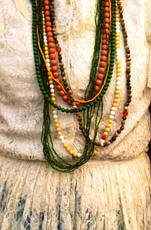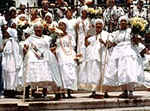Advertising by Google
Bahia syncretism
The word syncretism applies to cases where two religions are combined; the resulting religion is a religious syncretism. The Bahian syncretism is a combination of African Candomblé and the Portuguese Christianism.
 Knowing the power that religions may have to produce upheavals, the Portuguese masters prohibited black slaves from professing their original religions; Christianism was tolerated because, besides the strong influence of the jesuits who came from Europe to christianize blacks and indians, in the view of Catholicism, suffering is a way to heaven.
Knowing the power that religions may have to produce upheavals, the Portuguese masters prohibited black slaves from professing their original religions; Christianism was tolerated because, besides the strong influence of the jesuits who came from Europe to christianize blacks and indians, in the view of Catholicism, suffering is a way to heaven.
In order to get around the prohibition, the slaves disguised their gods as Catholic saints, and worshipped them. The saints are called orixás. The holy places of slaves, equivalent to Catholic churches, are called terreiros. Despite all efforts from the Portuguese, orixás and terreiros remained all over Bahia, side by side with Catholicism.
In Brazil, only a few of the more than two hundred African orixás are worshipped. The orixás have their roots in the ancestors of the African clans, deified around five thousand years ago. They are believed to have the power to control the forces of Nature.
One of the most important orixás is Exu, the intermediary between men and gods, the guardianof crossroads. Other orixás are Xangô, of fire and thunder; Iemanjá, of seas and oceans; and Iansã, of wind and lightning, owner of the souls of the dead.
Cults take place at the terreiros. The authorities of the terreiros are the ialorixá or mãe-de-santo (Portuguese for saint's mother), the priestess, and the babalorixá or pai-de-santo (saint's father), the high priest; both live in the terreiros.
Today, there are approximately two thousand terreiros in Salvador. The most famous ones are Ilê Axé Iyá Nassô Oká (opened in 1830, is the oldest terreiro in Brazil), Ilê Axê Opô Afonjá (opened in 1910, was declared Heritage Site by the State of Bahia) and Ilê Axé Iyá Omi Yamassê. This later one is referred to as Terreiro do Gantois, and had as ialorixá, for 64 years, Mãe Menininha do Gantois (1894 - 1986); she promoted the values of Candomblé and gained the admiration of personalities like Jorge Amado (writer), Caetano Veloso (singer) and Antônio Carlos Magalhães (most important politician in Bahia; so much so that he is usually referred to as "babalorixá of Bahia").
 The Igreja de Nosso Senhor do Bonfim is the best example of how the two religions merged; until today, parishioners unite once a year to honor both African and Christian Gods.
The Igreja de Nosso Senhor do Bonfim is the best example of how the two religions merged; until today, parishioners unite once a year to honor both African and Christian Gods.
The ritual washing of the steps of the Igreja do Nosso Senhor do Bonfim is held annually in January, onthe second Sunday following the Wise Kings Day (January 6th). The 8 kilometer (5 mi) procession to the hill of Bonfim starts at 10am infront of the Igreja de Nossa Senhora da Conceição da Praia, at the lower city of Salvador. From there, fiver hundred women dressed in traditional African attire depart towards the church. They pour water and sprinkle lavender on the first ten steps and wash, singing hyns in African languages.
The washing of Bonfim attracts thousands of visitors, both Brazilian and foreigners.
Visiting a terreiro, and receiving the bless of a ialorixá or babalorixá is a must for all visitors of Bahia.
Read more: Candomblé - African religion. Plenty of info in English.
Back to Top